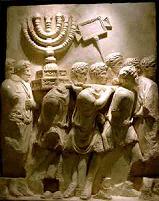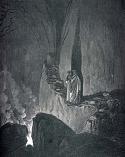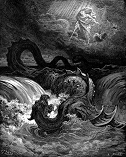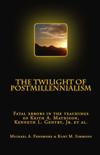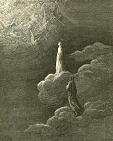"Bimillennialism"
A Contemporary-Historical Analysis of the Apocalypse
“It must be observed, that two distinct thousand years are mentioned throughout this whole passage." John Wesley
There are two basic interpretative models
of Revelation twenty current among full Preterists.
The view represented by my friend Don was first advanced
by Max King. This view says that Revelation’s millennium
(singular) refers to the “transition period” between the cross
and second coming.
King thus coined the phrase “transmillennial,” obtained a trade
mark for it from the
King’s view is simply a version of
Augustine’s Postmillennialism.
Postmillennialism says that the millennium represents a
symbolic period beginning with Christ’s earthly ministry until
the world’s end sometime in the future.
According to Augustine, the dragon is bound by the gospel
of Christ; the martyrs and confessors represent those who have
been regenerated by obedience to the gospel.[1]
King’s model differs from Augustine’s only in that it
foreshortens the long ages and futurism of Postmillennialism,
squeezing them into the forty-odd year period ending at the fall
of
The single greatest obstacle the
Augustine/King view presents to this writer’s mind is that the
symbolism is incongruous with the interpretation, which makes
those beheaded for the testimony of Christ represent individuals
who have experienced baptismal regeneration and thus “died with
Christ.”
[2]
Can we really believe that beheading represents
regeneration? For
that matter, if the dragon was bound beginning with Christ’s
earthly ministry, when and how did the martyrs die?
John says they died for their testimony of Christ (v. 4).
This means they died sometime after Christ’s
earthly ministry. How does this square with the idea that the
dragon was bound beginning with Christ’s ministry?
Doesn’t the fact the saints have suffered martyrdom
require that the dragon have first been loosed?
Can someone bound in prison kill innocent victims who are
free at large? If not,
doesn’t this mean that the 1000-year binding of the dragon ends
before the 1000-year reign of the martyrs begins?
We think so, and therefore have settled upon an entirely
different view, which we call “Bimillennialism.”
Two Millennial Periods
We said before that so long as the dragon
remained bound in prison, he could not bring about the
persecution of the saints, and that therefore the 1000-year
binding of the dragon necessarily ended before the 1000-year
reign of the martyrs began.
But if the one ends before the other begins, they
obviously cannot be the same period.
Thus, there are two millennial periods contemplated by
the text. With this
agrees Joseph Bengel, Thomas Brightman, A. E. Koch, Jim Millay,
Daniel Steele, and Anglican Reformer, John Wesley, among others,
who see two millennial periods in the text, rather than the
traditional one:
“It must be observed, that two distinct
thousand years are mentioned throughout this whole passage. Each
is mentioned thrice; the thousand wherein Satan is bound, verses
2, 3, 7; the thousand wherein the saints shall reign, verses
4-6. The former end before the end of the world; the latter
reach to the general resurrection. So that the beginning and end
of the former thousand is before the beginning and end of the
latter."[3]
Indeed, most explanations produce two
millennia if we but take the time to analyze them closely.
For example, King’s model says that the binding of the
dragon began with Christ’s ministry (Matt.
“This last persecution by Antichrist
will last for three years and six months, as we have already
said, and as is stated both in the Apocalypse and by the prophet
Daniel. Though this time is brief, it is rightly debated
whether it belongs to the thousand years during which it is said
that the devil is bound and the saints reign with Christ, or
whether this short span is to be added to those years and is
over and above them. For if we say that it belongs to the
thousand years, then it will be found that the reign of the
saints with Christ extends not for the same length of time as
the binding of the devil, but for a longer time…How, then
does Scripture include in the same limit of a thousand years
both the binding of the devil and the reign of the saints, if
the binding of the devil is to cease three years and six months
before the reign of a thousand years of the saints with
Christ?”[5]
Notice that Augustine admits that the
binding of the dragon and reign of the saints cannot be enclosed
within the same 1000-years, and that they extend “not for the
same length of time.” As with King’s model, they do not match!
If they do not match, they cannot be the same.
No matter which way we cut it, two millennial periods
emerge from the text.
Meaning of the Symbolism
So much for the fact of two millennial
periods, what does the symbolism mean?
Let us begin with the observation that both the dragon
and the saints/martyrs are physically dead. The saints have been
beheaded for their testimony of Christ (v. 4) and the dragon,
together with its alter ego, the beast, has received a mortal
wound to its head (Rev. 13:3, 12) and has descended to the place
of the dead. But if
both have experienced physical death, then both are in Hades.
The dragon, being wicked, is in the place assigned for
the dammed; the saints, being justified, are in the place
assigned for the saved.
John describes the dragon as being bound with a great
chain (v. 1). This is the identical imagery used by Peter to
describe the “angels” that sinned (probably the “sons of God”
(faithful) who apostatized by marrying the daughters of
unbelieving men – Gen. 6:2), and were cast down to Hades
Tartarus, where they were held in chains until the judgment:
“For if God spared not the angels that
sinned, but cast them down to hell (Gk. Tartarus), and delivered
them into chains of darkness, to be reserved unto judgment.”
II Pet. 2:4
This is the true source of John’s imagery,
not Matt. 12:29.
John is telling us that the dragon and beast suffered death in
the mortal wound they received, and were thus bound in Tartarus
(bottomless pit) for 1000-years.
The martyrs likewise have suffered death, and have
entered into a 1000-year rest pending the general, Hadean
resurrection. John
describes this same group of martyrs in chapter fourteen,
saying, “Blessed are the dead which die in the Lord from
henceforth: Yea, saith the Spirit, that they may rest from their
labours; and their works do follow them” (Rev. 14:13; cf.
vv. 9-12). We know that the martyrs died in the persecution
under the beast; when did the dragon and beast die?
Death and Resurrection of the Dragon and Beast
John tells us that the beast received a
mortal wound to one of its heads, but that its wound healed, and
thus arose to persecute the church again (Rev. 13:3, 14). John
also says that beast ascends from the bottomless pit to make war
with the saints (Rev. 11:7; 17:8, 14). Thus, the healing of the
wound marks the point at which it revives and ascends from the
place of the dead, and persecutes the church. But if persecution
marks the life of the beast, then what is the death of the beast
but the cessation of persecution?
Where did the beast receive the mortal wound? There are
only two persecutions in Revelation, one in chapter twelve,
which was past when John wrote, and one beginning in chapter
thirteen, that was about to break out.
The persecution in chapter twelve followed closely upon
the ascension of the “Man-child” (Christ) and therefore may be
identified as the great persecution under Caiaphas, Pilate and
Saul (Paul) that arose over Stephen (A.D. 34-38).
The dragon and beast went down to death in defeat when
this persecution collapsed; they
ascend again in chapter thirteen in the persecution
under Nero.
Thus, the dragon (and beast) was bound
during the period from the collapse of the persecution over
Stephen until the persecution under Nero.
This is the period during which Claudius was upon the
throne, enforcing the “religio licita,” which extended
protection of law to the national religions of the peoples of
the
This interpretation is consistent with what
we read elsewhere in the New Testament.
The Thessalonians were in fear that the eschatological
gathering into the kingdom by martyrdom was at hand (II Thess.
2:1), but Paul assured them that someone and something was
restraining the fanatical hatred of the Jews (the “mystery of
iniquity”) and the Roman power (vv. 6, 7).
This restraint thus answers the binding of Rev. 20:1-3,
and represents the political stability that obtained during the
reign of Claudius, but which was almost spent by the close of
Acts, shortly before Paul fell as a martyr under Nero.
The late Canon of Westminster, F.W. Farrar, could thus
write:
“St.
Paul, when he wrote from Corinth to the Thessalonians, had
indeed seen in the fabric of Roman polity, and in Claudius, its
reigning representative, the “check” and the “checker” which
must be removed before the coming of the Lord.”[6]
Whence the 1000-Years?
This accounts for Revelation’s imagery
based upon the historical situation existing at the time it was
written. What about
the symbolism of the 1000-years, how do we explain it?
In a letter recorded by Eusebius, Dionysius of Alexandria
alludes to Rev. 20:4, saying, “the divine martyrs themselves
among us, who now are assessors of Christ, and share the
fellowship of His kingdom, and take part in His decisions and
judge along with Him.”[7]
From this epistle we learn that the early church believed
that the martyrs were alive in Paradise and in some form or
manner reigned there with Christ.
Greeks and Romans believed that the dead lived in Hades
1,000 years, after which they were restored to earthly life.
In his epic poem, the Aeneid, Virgil causes his
lead character, Aeneas, a survivor of the Trojan war and
legendary founder of
Yes, not even when the last flicker of
life has left us, does evil, or the ills that the flesh is heir
to, quite relinquish our souls; it must be that many a taint
grows deeply, mysteriously grained in their being from long
contact with the body.
Therefore the dead are disciplined in purgatory, and pay
the penalty of old evil: some hang, stretched to the blast of
vacuum winds; for others, the stain of sin is washed away in a
vast whirlpool or cauterized with fire.
Each of us finds in the
next world his own level: a few of us are later released to
wander at will through broad Elysium, the Happy Fields; until,
in the fulness of time, the ages have purged that ingrown stain,
and nothing is left but pure ethereal sentience and the spirit’s
essential flame. All
these souls, when they have finished their thousand-year
cycle, God sends for, and they come in crowds to the river
Lethe, so, you see, with memory washed out, they may revisit the
earth above and begin to wish to be born again.[8]
Revelation was written to Greek and Latin
speaking Gentiles in
The
belief in this reign of a thousand years was long prevalent
among the Christians. This period was also in great credit among
the Gentiles. The souls of the Egyptians returned to their
bodies at the end of a thousand years; and, according to Virgil,
the souls in purgatory were exorcised for the same space of
time—et mille per
annos.[9]
If a learned skeptic recognized the
connection between John’s imagery and ancient notions of Hades,
it is difficult to imagine that contemporary Christians of Greek
descent could fail to see it also. Indeed, the epistle of
Dionysius of Alexandria quoted above stands as testimony that in
fact they did.
Conclusion
Revelations millennia (two) describe the intermediate realm of Hades where the dragon went down in defeat upon the collapse of the persecution over Stephen, to rise again in the persecution under Nero, but where the saints and martyrs dwelt in happiness pending the general, Hadean resurrection.
[1] “Since, then, there are two regenerations…one after the faith, which even
now come about through baptism; the other after the
flesh, which is to come about in its exemption from
decay and death…so there are two resurrections: one, the
first, of the soul, which now is, and which prevents us
from coming into the second death; the other, the
second, which is not now, but is to be at the end of the
world.”
Augustine, City of
[2] “Who are these souls?
They are the millennial saints, the believers in
Christ from the cross to the end of the old aeon of
salvation-history. They are the ‘pre-end-of-the-age’
saints who came to life in advance of the end of history
(the Jewish age).
They came to life through death and resurrection
‘with Christ’…They attained unto fullness of
resurrection life ‘with’ Christ’ (by dying and rising
with Him) in advance of the end of the age.”
Max R. King, The Cross and the Parousia of
Christ (1987,
[3] John Wesley, Commentary on Revelation, in loc.
[4] Max R. King, Spirit of Prophecy
(1971,
[5] Augustine, The City of God, XX, xiii; Loeb ed.
[6] F.W. Farrar, The Early Days of
Christianity (1891, Columbian Publishing Co, NY), p.
13; cf. The Life and Work of
[7]
Eusebius,
Ecclesiastical History VI, xlii, 5; Loeb ed.
[8]
Virgil, Aeneid,
lines 735-51; C. Day Lewis ed;
cf. Plato,
Republic, X, 614
[9]
The Works of
Voltaire, Vol. III, sec. 1 (1764, Philosophical
Dictionary, Part I)
To receive Kurt Simmons’ e-mail newsletter, The Sword & The Plow, click the Subscribe link:
All rights reserved.
